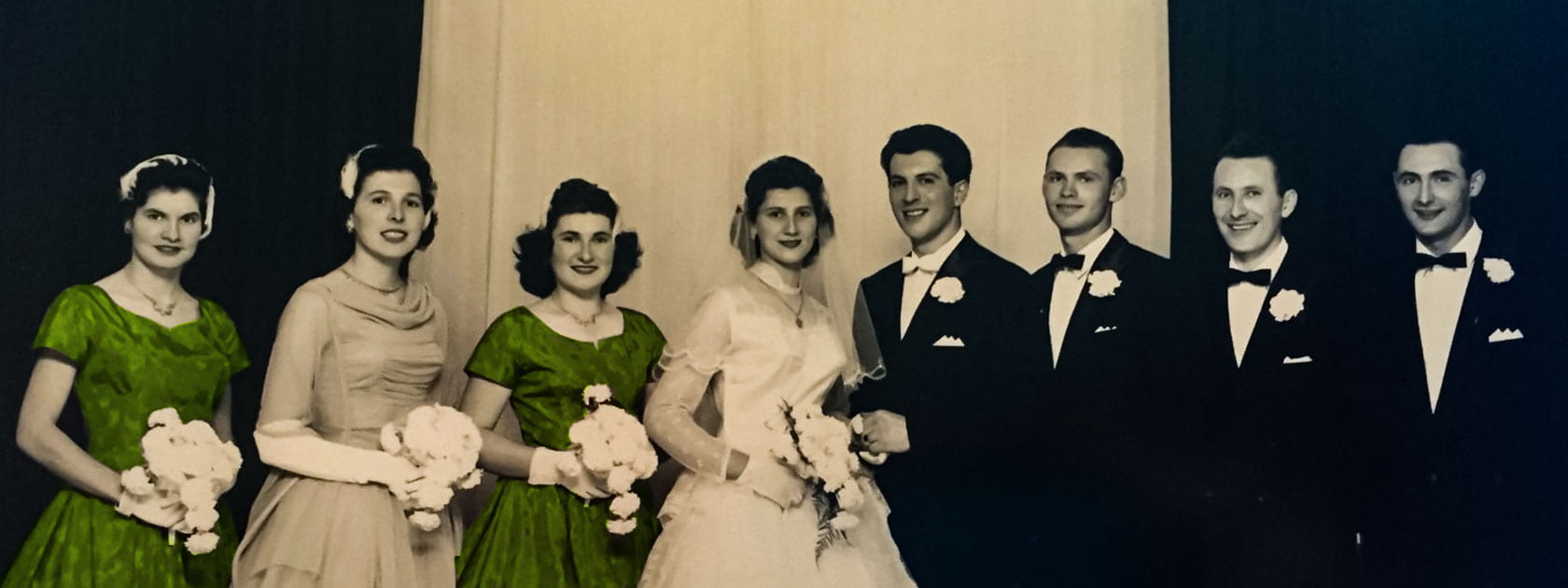Italian Canadians Today
[The] actions [of the Italian government] threw the Italian community of Toronto into a most unfavourable and unjust light. However, the subsequent action of Canadians of Italian extraction in Canada during the war was a sufficient answer to their critics. They proved themselves to be loyal, reliable and intelligent Canadian citizens, valuable members of the Canadian community.
Arthur W. Roebuck, Liberal Member of Parliament, in a letter to Eliseo Orlando, ex-internee, October 16, 1951
Today, Italian Canadians are a successful group. They are businessmen, skilled professionals, artists and innovators in every field.
Immediately after the war, however, the Italian Canadian community became fragmented. Individuals feared being targeted again by the Canadian government. Those who were affected by the War Measures Act attempted to return to a normal life as quickly as possible. Others anglicized their names to escape the stigma associated with being Italian.
Once released, many of the internees and their families had no choice but to start over. Italian Canadians also had to work to rebuild community organizations.
There were many changes as a result of the massive influx of new immigrants from Italy. In the post-war years, from 1950 to 1970, Canada saw its highest numbers of Italian immigrants yet. Numbering about 500,000, these new Italian Canadians surpassed the number of earlier immigrants. As a result, they began to redefine what it meant to be Italian Canadian.
Although some Italian Canadians were cautious about associating with the “new” Italians, for the most part, the existing community welcomed the new arrivals. By working together, the community benefitted from Canada’s post-war boom and the Canadian government’s approval of the Multiculturalism Act. Italian Canadians became identified with strong family values and a solid work ethic, which played an important role in building the infrastructure of cities and in the construction industry in general. Although Italian Canadians are still challenged by the harmful stereotypes of the past, they have flourished and are now firmly established in Canada.
Post-War Realities
- All internees had their assets administered by the Custodian of Enemy Property. In some cases, an internee’s properties and personal belongings were sold at a fraction of their worth. Although some internees were able to return to their jobs, many others had to find new employment.
- The Casa d’Italia buildings were seized by the Canadian government in June 1940. In 1947, the Italian Canadian community of Montreal petitioned successfully to have the Casa d’Italia on Jean Talon St. returned to them. In Toronto, in 1962, after a long battle, the Casa d’Italia on Beverly St. was returned to the community. The Order Sons of Italy lodges re-convened, but many former members were afraid to rejoin the organization, fearful that their membership in such a group might again be used against them.
- After their homeland was torn apart during World War II, many Italians migrated to escape poor economic conditions. The post-war immigrants gravitated to the existing Little Italies, which provided a place where they could meet other Italian newcomers. They were able to maintain their culture and traditions. And a new language was born: Italiese is the blend of Italian and English. By 1980, the Italian Canadian community had become one of the largest in Canada after the English and French Canadian. The majority of these new immigrants settled in the Greater Toronto Area, thereby shifting the base away from Montreal, which had had the largest Italian community in Canada prior to the war.
Redress and Apology
I would say to [the Prime Minister]: Look it, you have an obligation to the children of internees. They suffered hardships because your underlings exploited the authority that they had by disallowing us assistance. If I didn’t have my grandparents, either my mother would be washing floors or on the streets. One of the two. So I was lucky. So, what the problem is—I mean you don’t even say you’re sorry. Or thank you, or go to hell.
Attilio Girardi, son of internee Bruno Girardi, video interview, Columbus Centre Collection
Rino Albanese, son of enemy alien Giovanni Albanese, video interview, Columbus Centre Collection
I have more feelings towards people of Japanese descent [than Italian Canadians]. I figured they got a dirty deal when they were interned. Because to me it wasn’t a selective internship for them. It was just everybody.
Nellie Cavell, enemy alien, Vancouver, video interview, Columbus Centre Collection
I would not expect to be compensated. I’m not of that school that thinks for every little thing that goes on you have to be compensated.
Sandy Corbo, granddaughter of internee Achille Corbo, Montreal, video interview, Columbus Centre Collection
In as much as the soldiers have been honoured [in the Peace Tower in Ottawa], I think the people who have been falsely accused of something should be honoured in the same way. Their names should be written down as a memorial.
Attempts at redress have been controversial among Italian Canadians. Some feel that Italian Canadians should receive financial compensation or, at the very least, be given a public apology by the prime minister in the House of Commons. Others believe that it is too late for an apology since the majority of internees and enemy aliens have passed away.
Redress initiatives began after World War II. Former internees in Hamilton and Montreal petitioned the Canadian government for lost wages, lost businesses and emotional distress. They were unsuccessful.
In January 1990, the National Congress of Italian Canadians (NCIC) published a brief asking the federal government to compensate Italian internees wherever possible. They also requested that the government apologize to Italian Canadians for the treatment they received during the internment years. Later that year, Prime Minister Brian Mulroney expressed an apology at a luncheon held north of Toronto.
In Prime Minister Paul Martin’s 2005 federal budget, the Canadian government set aside $25 million to address the claims of several communities seeking redress for internment, confiscation of property and businesses, and alienation. This was called the Acknowledgement, Commemoration and Education (ACE) Program. It was not the formal apology many had hoped for, nor would it provide compensation to the families affected. The fund was designated primarily for educational initiatives. When Prime Minister Stephen Harper’s government took office in 2006, it replaced the ACE Program with the Community Historical Recognition Program (CHRP), which was established to formally distribute monies to community initiatives.
In 2009 Massimo Pacetti, Liberal MP for Saint Léonard-Saint Michel, introduced Bill C-302 in the House of Commons. The bill called for the creation of a foundation to develop educational materials on Italian Canadian history – to be used in schools and cultural centres – and a commemorative stamp. Bill C-302 did not pass through the necessary stages to become law.
Things to Consider
- The internment period is a little-known event, even among the Italian Canadian community. In fact, the majority of Italian Canadians today have a different family history of the war. Their wartime stories centre on service in the Italian military, Nazi patrols and occupation, Allied bombings, resistance efforts, as well as hunger and depravation. What happened in Canada is not part of the majority’s “personal” history.
- In 1940, the Italian community in Montreal was the largest in the country and the most affected by the internment and wartime designations. Montreal is now second to the Toronto-based Italian community, whose vast majority represents post-war immigrants. As a result, the voice of the Toronto community, with its interests and needs, is the one that is most often heard in public.
- The Italian Canadian community has not embraced the internment as part of its collective history. Although much valuable work was undertaken in the 1990s, it has not taken root. A genuine debate and dialogue throughout the community did not result; and as a consequence, the community does not have a unified position to advocate to the Canadian government and the Canadian public.



